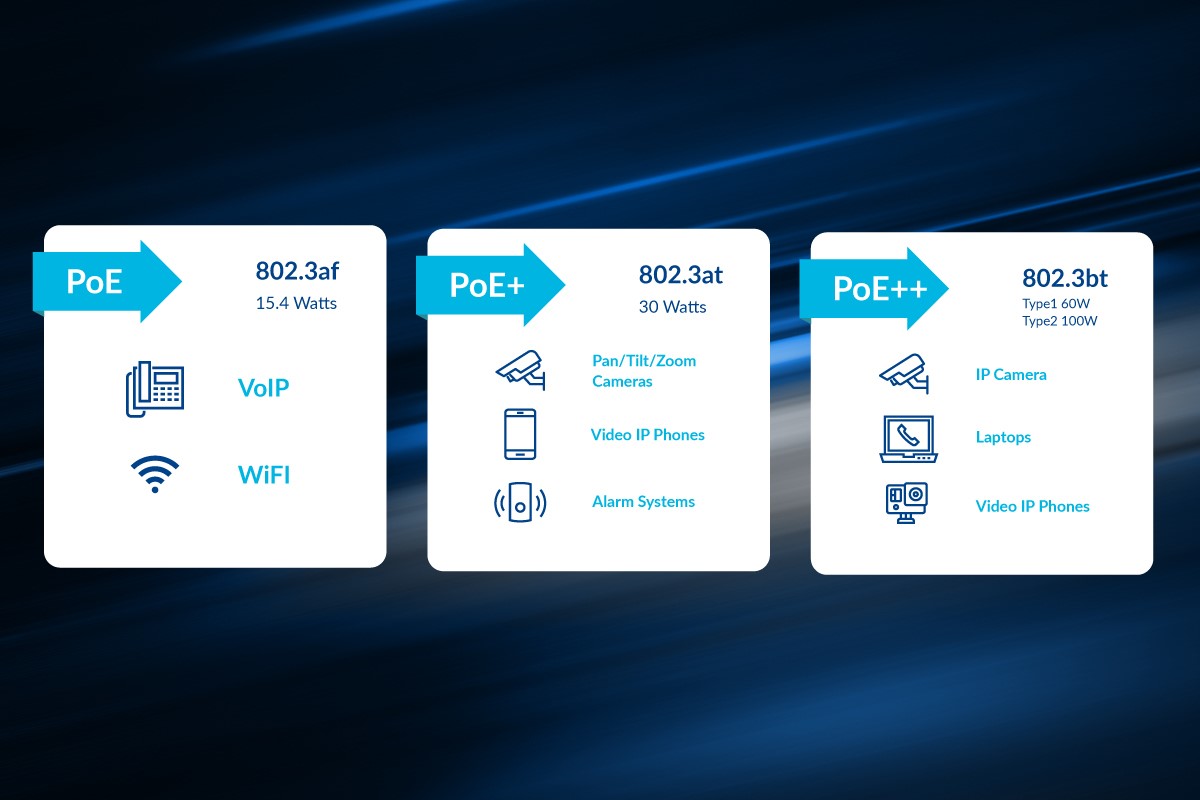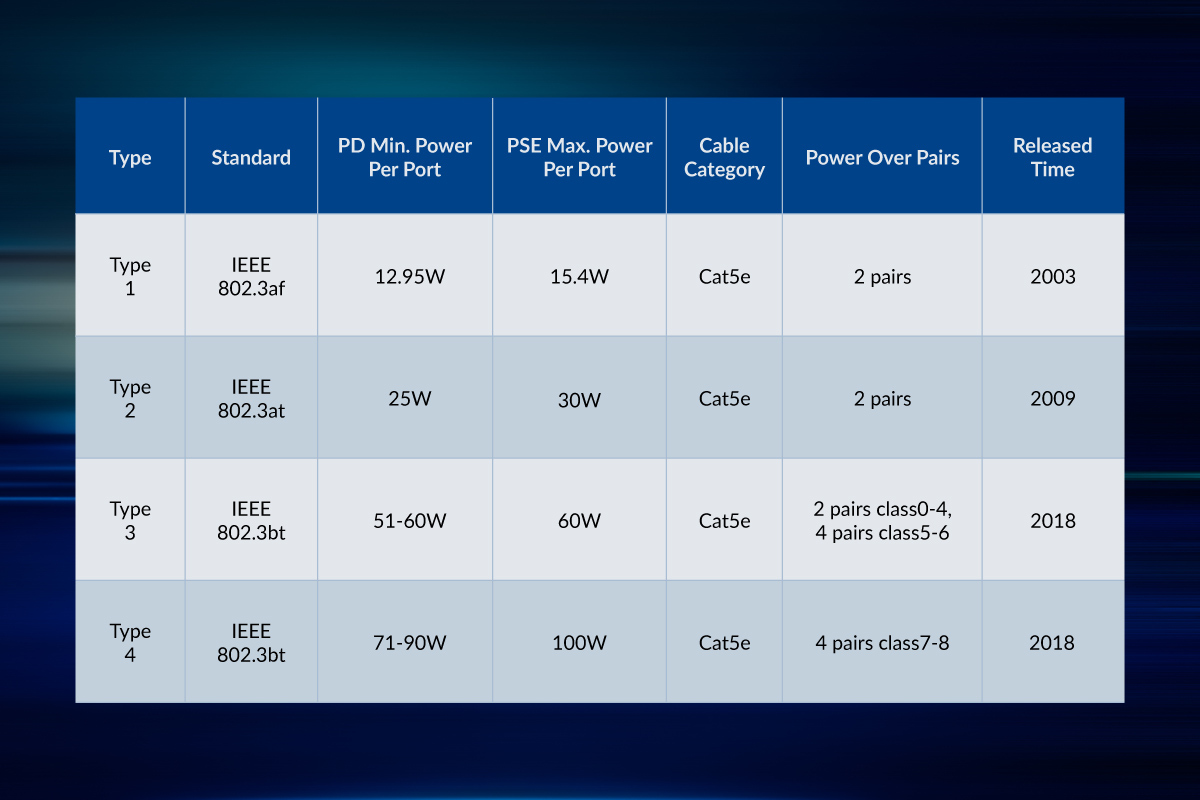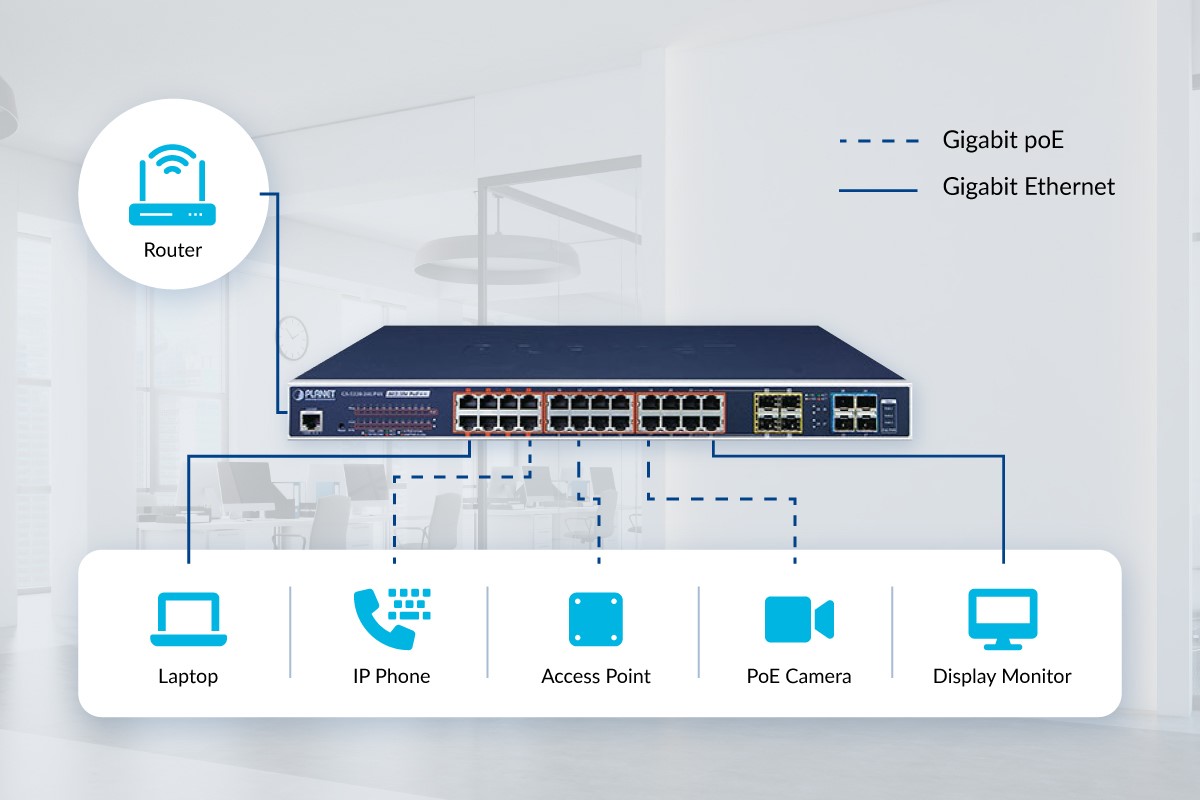PoE Standards
Power over Ethernet (PoE) technology allows Power Sourcing Equipment (PSE) to use twisted pair ethernet cables to supply both power and data simultaneously to a Powered Device (PD), which can make cabling installation much more straightforward and save money.
The Institute of Electrical and Electronics Engineers (IEEE) released IEEE 802.3af, IEEE 802.3at and 802.3bt to regulate how much power can be supplied to those Powered Devices.
How much do you know about these PoE standards?
How many PDs can you connect to a PSE based on different PoE wattages?
Standards Introduction
The PoE standard currently has IEEE 802.3af, IEEE 802.3at and IEEE 802.3bt. These standards define the minimum power PSE can source and the maximum power the PD will expect to receive.

802.3af (PoE)
IEEE 802.3af, also known as standard PoE, can supply a voltage of 44-57V and a current of 10-350mA. The maximum power output of this standard to a port is limited to 15.4W. However, the ethernet cable will lose some power. Because of this, the guaranteed maximum power available at the Powered Device (PD) is 12.95 watts per port. PoE (802.3af) can support VoIP phones, wireless access points and similar low-power devices.
802.3at (PoE+)
The IEEE 802.3at standard is also known as PoE+ (PoE+ is backwards compatible with PoE). PoE+ can supply a voltage between 50V to 57V, with a current supply between 10 - 600mA. It can provide up to 30W of power per port on a PSE. But due to the power loss mentioned above, the minimum power available at the Powered Device (PD) will be 25W. PoE+ (802.3at) can support devices that require more power, like PTZ IP Cameras, alarm systems and video IP phones.
802.3bt (PoE++ or PPoE)
IEEE 802.3bt is the latest PoE standard, incorporating two levels – Type 3 and Type 4. These additional standards will increase the maximum power by using two or more twisted pairs. Type 3 and Type 4 modes allow the PSEs to identify the PDs and set the power accordingly, resulting in a better power-delivery system.
802.3bt Type 3
Type 3, also known as PoE++, can provide up to 60W per PoE port (minimum power on each port is 51W) over a single ethernet cable to power devices like video conferencing equipment.
802.3bt Type 4
Type 4 is named higher-power PoE and can provide up to 100W per PoE port (minimum power on each port is 71W), which is suitable for high-power devices like TVs, laptops, etc.
Types 3 & 4 of IEEE 802.3bt are backwards compatible with 802.3af and 802.3at. The table below lists the specifications of the PoE standards mentioned above.

How Much Wattage Can PoE Switches Provide?
IEEE 802.3af and 802.3at are the most common PoE standards that many devices can support. IEEE 802.3bt was only released in the last few years and is not currently in large-scale use. Only a handful of vendors' products support this standard, such as the Planet GSD-504UP, the smallest unmanaged Gigabit PoE++ switch from Planet. The GSD-504UP has two IEEE 802.3bt ports and two IEEE 802.3af/at ports. Because of this, we will discuss the IEEE 802.3af and 802.3at standards.
As mentioned above, standard PoE can provide 15.4W maximum power output, whilst PoE+ can provide 30W. When a plan calls that multiple devices need to connect to one PoE/PoE+ switch, it is necessary to ensure that the total wattage required does not exceed the maximum wattage of the switch. Using the Planet GSW-2620HP PoE/PoE+ switch as an example. It's an unmanaged 24-port switch with 2 SFP ports. This switch complies with IEEE 802.3af/at and has a PoE power budget of 240W. This means that this 24-Port switch can provide both PoE and PoE+ power. This switch can connect 15 (15.4W x 15 = 231 < 240W) devices with PoE standards, and it can support 8 (30W x 8 = 240W = 240W) devices with PoE+ standards.

If a network switch supports IEEE 802.3af/at standards, it can automatically detect if the connected devices are compatible with PoE or PoE+ and supply the device with the necessary power. For example, by connecting a PoE device requiring 5W power to the GSW2620HP PoE/PoE+, the switch will provide 5W power. If we connect a device to the switch that requires 20W power, the switch will supply 20W power to that device. And if we connect a non-PoE device to the PoE switch, the switch will only provide data to the device.
Cablenet Network Switches That Comply With Various PoE Standards
Cablenet has PoE/PoE+ switches that follow the PoE standard for higher security and better ability. They are available in 8/16/24 & 48 port options. These switches support layer 2+ switching features like VLAN. They also offer advanced management like WEB, CLI, TELNET, and SNMP. Cablenet PoE/PoE+ switches can power any 802.3af or 802.3at device on the market, making them flexible and secure. The following table lists the specifications of three Cablenet PoE/PoE+ switches.
| PoE Standard | Model | Ports | Switch Capacity | Forwarding Rate | Power Budget |
|---|---|---|---|---|---|
| IEEE 802.3af/at | GSD-908HP | 8 x RJ45 | 18Gbps | 13.3Mpps | 100W |
| IEEE 802.3af/at | GSW-1820HP | 16 x RJ45 + 2 x SFP | 36Gbps | 26.8Mpps | 240W |
| IEEE 802.3af/at | GS-4210-48P4S | 48 x RJ45 + 4 x SFP | 104Gbps | 77.38Mpps | 400W |
Summary
PoE standards specify the maximum power a PSE can provide, protecting PoE-enabled devices from high-voltage damage. Additionally, PoE technology can make the cabling installation more manageable and save you money. It is especially suitable for PoE electronic billboards or PoE electronic displays.
